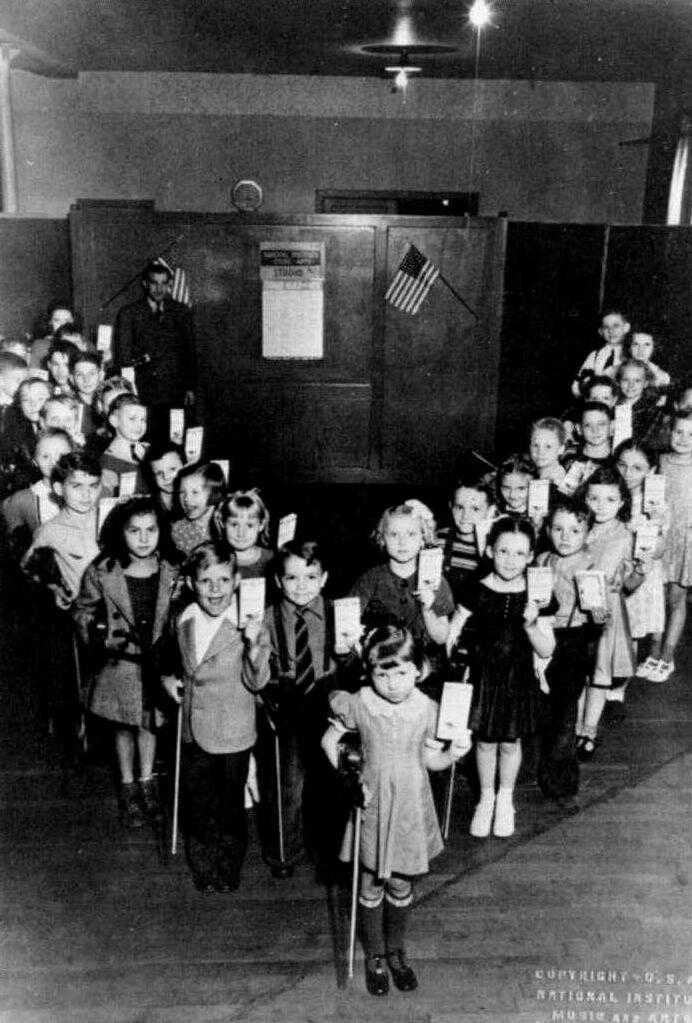
The Arsenal of Democracy: Financing the War--Borrowing

Figure 1.--The U.S. Government launched a major effort to sell War Bonds. Adults bought the bonds. Children cold participate at schoool by buying Liberty Stamps each week until they had enough for a bond. The schools heavily promoted the Liberty Stamps. The bonds not only helped finance he War effort, but helped soak up earnings to limit inflation. They were still selling the stamps in the 1950s. I like they were then called Saving Stamps. These music students were at the National mInstitute of Music and Arts in Bremerton Washington. They are holding up their War Bond Liberty Stamp books. There was an important shipyyard at Bremerton.
|
|
The U.S. Federal Government used a variety of measure to finance the war. This included deficit spending, increased taxes, and borrowing. a war bond campaign. The United States Government, even before America entered the War, initiated an ambitious advertising campaign to sell bonds. Before America actually entered the war they were called Savings Bonds. The War Advertising Council and the War Finance Committee sought to promote bond sales to finance the War and build civilian morale. The work of these World War II organizations produced "the greatest volume of advertising and publicity ever given to any product or agency" in American history. Secretary of the Treasury Henry Morgenthau sold the first Series E U.S. Savings Bond to President Franklin D. Roosevelt on May 1, 1941. The War Finance Committees sold over $185 billion of securities. By the end of World War II, over 85 million Americans had invested in War Bonds, a number unmatched by any other country. Even American children participated in the effort. Children bought Liberty stamps every week in their schools.
Taxes
Taxes during the war covered slightly more than 40 percent of the cost. The Federal Government had to borrow the reminder. Here there were several alternatives. Congress could have increased taxes to astronomical levels or it could have adopted some kind of compulsory war bond purchase scheme. Both alternatives were rejected. Congress did increase taxes. The Revenue Act of 1942 substatially changed the Federal tax system. Many more individuals were required to pay income taxes, including Americans with modest salaries. The number of taxpayers were increased from 13 million to 50 million people. The tax was highly progressive with wealthy people paying a larger percentage. Corporations were also affected by excess profits taxes.
The War Advertising Council and the War Finance Committee sought to promote bond sales to finance the War and build civilian morale. The work of these World War II organizations produced "the greatest volume of
advertising and publicity ever given to any product or agency" in American history. Secretary of the Treasury Henry Morgenthau sold the first Series E U.S. Savings Bond to President Franklin D. Roosevelt on May 1, 1941. Congress chose to finance the war primarily by borrowing from financial institutions and individuals. The Federal Government launched well publicized drives to sell war bonds on a voluntary basis. The drives were supported by Hollywood celberties and decorated service men. Even children participated in these drives. They could buy Defense Saving Stamps and when they filled up their book a bond would be issued. This process began even before the Japanese Pearl Harbor attack brought America into the War (1941). There were several drives. We note a Sherman tank being used in the Third War Bond Drive (1943). The Government's financial policy also included measures to control inflation because the increased employment increased incomes at a time when the supply of consumer goods was limited. The War Bond drives not only help finance the war, but took money out of the cosumer economy and thus limited both inflation and consumer demand competing with war production. Secretary of the Treasury Henry Morgenthau sold the first Series E U.S. Savings Bond to President Franklin D. Roosevelt on May 1, 1941. The War Finance Committees sold over $185 billion of securities. By the end of World War II, over 85 million Americans had invested in War Bonds, a number unmatched by any other country. Even American children participated in the effort. Children bought Liberty stamps every week in their schools.
Defecit Spending
President Rooselvelt had been criticized for the New Deal defecit spending during the 1930s. This oproved to be a small fraction of what the War cost. All the borrowing caused the national debt to baloon five times to $259 billion.
HBC

Navigate the Boys' Historical Clothing Web Site:
[Return to Main U.S. financing World War II page]
[Return to Main Arsenal of democracy page]
[Return to Main World War II economics page]
[Return to Main U.S. World War II page]
[Return to Main World War II page]
[Introduction]
[Activities]
[Biographies]
[Chronology]
[Clothing styles]
[Countries]
[Bibliographies]
[Contributions]
[FAQs]
[Glossaries]
[Images]
[Links]
[Registration]
[Tools]
[Boys' Clothing Home]
Created: 5:19 AM 5/24/2011
Last updated: 5:19 AM 5/24/2011



